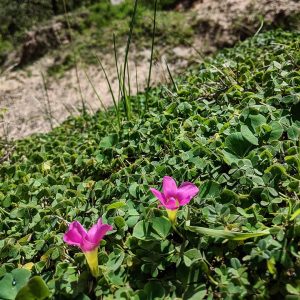Large-flower wood-sorrel (Oxalis purpurea), a South African perennial bulb adopted as a garden ornamental. Typically flowering a bright magenta as seen here, white and pale-pink varieties are available and have unsurprisingly also escaped throughout Australia.
Large-flower wood-sorrel was listed in Melbourne nursery catalogues from at least 1864. The species has also confusingly been called Purple Oxalis, an appellation used for several other species, including the purple-leaved Oxalis regnellii; in 1888 one of these species was reportedly a planting in the display beds at the Royal Exhibition Building in Carlton Gardens, where it was used as an internal edging between an exterior row of dwarf Echeveria and central masses of scarlet anemone.
By 1895, the plant had been collected in WA, and in the Adelaide Hills in 1900. The first Victorian collections appear surprisingly late, in Burwood’s Wattle Park in 1946, in Studley Park in 1947, and at the Dookie Agricultural College in 1955. It is likely that the plant was persisting locally in various places in Victoria prior to that date but had been overlooked or associated with earlier cultivation and not collected.
This late dispersal does correspond to increasing adoption of mechanical construction and maintenance equipment. As with other woodsorrels in this country, mechanical transport of the tiny, egg-shaped bulbs is the principal means by which Oxalis purpurea reaches new sites, as the populations are generally incapable of producing fertile seed in Australia.
The photographed plants were found growing along the Upfield railway cuttings through Princes Park in Melbourne and, coincidentally, along the Princes Highway in Werribee, each named for a different dead English royal.
View Original Post on Instagram
Search for information about Oxalis purpurea in the Flora of Victoria
View information and occurrences of Oxalis purpurea on the Atlas of Living Australia










